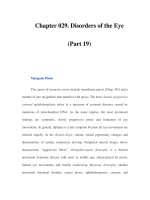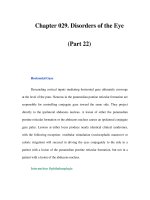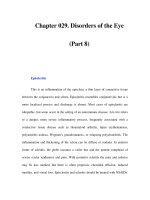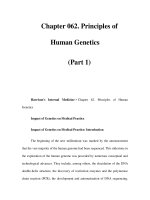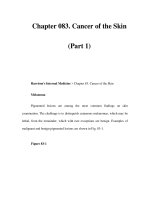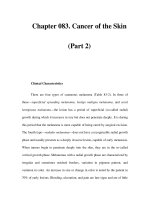Chondral Disease of the Knee - part 1 ppsx
Bạn đang xem bản rút gọn của tài liệu. Xem và tải ngay bản đầy đủ của tài liệu tại đây (659.59 KB, 15 trang )
Chondral Disease of the Knee
This is trial version
www.adultpdf.com
Chondral Disease of
the Knee
A Case-Based Approach
Brian J. Cole, MD, MBA
Associate Professor, Department of Orthopedics
and Department of Anatomy and Cell Biology
Director, Cartilage Restoration Center at Rush
Rush University Medical Center, Chicago, Illinois
M. Mike Malek, MD
Director, Washington Orthopaedic and Knee Clinic, Fairfax, Virginia
President, National Knee Research and Education Foundation,
Clinton, Maryland
Springer
This is trial version
www.adultpdf.com
Brian J. Cole, MD, MBA M. Mike Malek, MD
Associate Professor, Director, Washington Orthopaedic and
Department of Orthopedics and Knee CUnic, Fairfax, VA 22031
Department of Anatomy and President, National Knee Research
Cell Biology; Director, Cartilage and Education Foundation
Restoration Center at Rush Clinton, MD 20735
Rush University Medical Center USA
Chicago, IL 60612
USA
Library of Congress Control Number: 2005937074
ISBN
10:
0-387-30830-X
ISBN
13:
978-0387-30830-2
© 2006 Springer Science+Business Media, LLC
All rights reserved. This work may not be translated or copied in whole or in part without
the written permission of the publisher (Springer Science+Business Media, LLC, 233
Spring Street, New York, NY 10013, USA), except for brief excerpts in connection with
reviews or scholarly analysis. Use in connection with any form of information storage and
retrieval, electronic adaptation, computer software, or by similar or dissimilar methodol-
ogy now known or hereafter developed is forbidden.
The use in this publication of trade names, trademarks, service marks, and similar terms,
even if they are not identified as such, is not to be taken as an expression of opinion as to
whether or not they are subject to proprietary rights.
While the advice and information in this book are believed to be true and accurate at the
date of going to press, neither the authors nor the editors nor the publisher can accept any
legal responsibility for any errors or omissions that may be
made.
The publisher makes no
warranty, express or implied, with respect to the material contained herein.
Printed in China. (BS/EVB)
987654321
springer.com
This is trial version
www.adultpdf.com
Contents
Introduction to Case Studies vii
1 Osteochondritis dissecans of the medial femoral condyle
with documented long-term natural history 1
2 Avascular necrosis 4
3 Unstable in situ osteochondritis dissecans of the medial
femoral condyle 6
4 Unstable in situ osteochondritis dissecans of the medial
femoral condyle 10
5 Concomitant medial meniscus tear and focal chondral
defect of the medial femoral condyle 14
6 Isolated focal chondral defect of the medial femoral
condyle 17
7 Symptomatic focal chondral defect of lateral femoral
condyle 20
8 Isolated small grade IV medial femoral condyle chondral
lesion 23
9 Isolated medial compartment osteoarthritis 25
10 Unicompartmental bipolar disease 28
11 Medial femoral condyle focal chondral defect 31
12 Lateral femoral condyle focal chondral defect 35
This is trial version
www.adultpdf.com
vi Contents
13 Focal chondral defect of the medial femoral condyle and
patella 38
14 Lateral femoral condyle osteochondritis dissecans 42
15 Focal chondral defect of the lateral femoral condyle 46
16 Contained focal chondral defect of the medial femoral
condyle 50
17 Contained focal chondral defect of the medial femoral
condyle 55
18 Osteochondritis dissecans of the medial femoral
condyle 58
19 Osteochondritis dissecans of the lateral femoral
condyle 62
20 Uncontained focal chondral defect of the lateral
trochlea 66
21 Failed prior fresh osteochondral allograft of the medial
femoral condyle 70
22 Lateral meniscus deficiency 73
23 Prior medial meniscectomy and focal chondral defect medial
femoral condyle 76
24 Failed anterior cruciate ligament reconstruction with medial
meniscus deficiency 80
25 Advanced patellofemoral arthritis 84
26 Multiple chondral defects 87
27 Traumatic patellar instabihty with focal chondral defect of
the patella 91
28 Focal chondral defect patella 95
29 Focal chondral defect medial femoral condyle and varus
alignment 98
30 ACL deficiency with symptomatic trochlear and medial
femoral condyle chondral lesions 102
31 Focal chondral defect of the medial femoral condyle in a
previously meniscectomized knee 107
This is trial version
www.adultpdf.com
Contents vii
32 Focal chondral defect lateral femoral condyle, prior lateral
meniscectomy, and small focal chondral defect lateral tibial
plateau Ill
33 Bipolar focal chondral defects of the patellofemoral joint
with patellar instabihty 116
34 Bipolar focal chondral defects of the patellofemoral
joint 120
35 Lateral compartment tibiofemoral degenerative
arthrosis 124
36 Isolated patellofemoral arthritis 128
37 Posttraumatic medial femoral condyle defect, varus
instabihty, and deformity with significant motion loss 132
38 Chondral defects with prior medial and lateral
meniscectomy and varus alignment 138
Index 143
This is trial version
www.adultpdf.com
Section Editors
Brian J. Cole, MD, MBA
Department of Orthopedics
Department of Anatomy and Cell Biology
Cartilage Restoration Center at Rush
Rush University Medical Center
Chicago, IL 60612
USA
Michael G. Dennis, MD
Orthopaedic Care Center
Aventura Hospital and Medical Center
Aventura, FL 33180
USA
Contributors
Tim Bryant, RN
Brian J. Cole, MD, MBA
Jack Farr, MD
Tom Minas, MD, MS
This is trial version
www.adultpdf.com
Introduction to Case Studies
The illustrated case studies were prepared to help sohdify the decision-
making required for patients who are diagnosed with chondral disease
of the knee. The cases are organized by level of complexity, taking into
consideration substantial comorbidities such as tibiofemoral and
patellofemoral malahgnment, ligament disruption, and meniscal defi-
ciency. The cases are presented in increasing level of difficulty based
upon the defect- and patient-specific factors considered in the final treat-
ment recommendation. Similar to the way a downhill ski run is graded
for its level of difficulty, the cases are rated using green circles (easiest
decision-making), blue squares (intermediate decision-making), black
diamonds (advanced decision-making), and double black diamonds
(expert decision-making). Within each category, the cases are organized
by increasing complexity as well. Based upon the reader's practice expe-
rience, some may feel more comfortable with the decisions made in one
category versus another. We beheve, however, that this is the best way
to convey the implicit level of complexity, thereby allowing the reader
to better understand how these cases fall within the treatment algorithm.
When off-label usage of technology was implemented, it is clearly indi-
cated within the body of the case. While mastering the techniques and
performing a thorough evaluation of all patient- and defect-specific
factors is a prerequisite to sound judgment, the bullet points at the end
of each case that emphasize the final rationale for the treatment chosen
will be of particular interest and value to the reader.
Brian
J.
Cole,
MD, MBA
M. Mike Malek, MD
Genzyme Biosurgery is proud to have collaborated with Springer to
support the publication of this book. We are committed to improving
patient care through education, research and advancing the field of car-
tilage repair. We applaud the efforts of the book's contributors and
believe this text will be a valuable reference for clinicians seeking expert
guidance in this emerging field.
Genzyme Biosurgery
A division of Genzyme Corporation
Cambridge, MA
This is trial version
www.adultpdf.com
PATHOLOGY
Osteochondritis dissecans of the medial femoral condyle with documented
long-term natural history
TREATMENT
Nonoperative treatment
SUBMITTED BY
Brian J. Cole, MD, MBA, Rush Cartilage Restoration Center, Rush
University Medical Center, Chicago, lUinois, USA
CHIEF COMPLAINT AND
HISTORY OF PRESENT ILLNESS
The patient is currently a 39-year-old male
orthopedic surgeon who was diagnosed with
symptomatic osteochondritis dissecans of his
medial femoral condyle of his left knee at the
age of
14.
At that
time,
he complained of weight-
bearing pain and discomfort on the medial
aspect of his left knee with activity-related
swelling. When initially diagnosed as having
osteochondritis dissecans, he was treated with 8
weeks of nonweight bearing with crutches and
asked to refrain from sports or impact activities
thereafter. He remained asymptomatic, but was
followed up regularly for radiographic evalua-
tion to assess for evidence of instability.
PHYSICAL EXAMINATION
He ambulates with a nonantalgic gait and
stands in symmetric physiologic varus. He has
no effusion and full range of motion. He has no
tenderness over his medial femoral condyle.
His entire knee examination is normal.
RADIOGRAPHIC EVALUATION
A series of radiographs obtained from the age
of 14 to the present demonstrate persistence of
the osteochondritis dissecans lesion with no
progression or evidence of instability.
Radiographs demonstrate a lesion of osteo-
chondritis dissecans of the medial femoral
condyle of his left knee (Figures Cl.l through
C1.3).
FOLLOW-UP
The patient remains completely asymptomatic
and active in several high-level sports including
skiing and running. Serial radiographs demon-
strate persistence of the lesion.
DECISION-MAKING FACTORS
1.
Diagnosed early at a time when growth
plates remained open.
2.
Initial attempt at nonoperative treatment
with protected weight bearing was success-
ful in rendering him asymptomatic.
3.
Despite persistence of the lesion demon-
strated on plain radiographs and magnetic
resonance imaging (MRI), he remains
asymptomatic and highly active.
4.
An identified target lesion that can be
reliably followed clinically and radio-
graphically for evidence of progression or
instabihty.
This is trial version
www.adultpdf.com
Case 1
FIGURE
Cl.l. Initial radiographs of a 14-year-old
male with symptomatic osteochondritis dissecans of
the left knee. Anteroposterior (A) and lateral (B)
radiographs demonstrate an in situ lesion of
osteochondritis dissecans of the medial femoral
condyle.
FIGURE
CI.2. Radiographs obtained 24 years later.
Anteroposterior (A) and lateral (B) radiographs
demonstrate no evidence of fragmentation or
collapse. (C) Coronal MRI demonstrates no frag-
mentation or evidence of significant instability.
This is trial version
www.adultpdf.com
Case 1
FIGURE CI.3. Radiographs obtained 29 years later.
Anteroposterior (A) and lateral (B) radiographs
demonstrate no evidence of fragmentation or col-
lapse. (C) Coronal MRI demonstrates no fragmen-
tation or evidence of significant instability. No
significant interval change is seen compared to
Figure CI.2.
This is trial version
www.adultpdf.com
PATHOLOGY
Avascular necrosis
PROCEDURE
Total knee replacement
SUBMITTED BY
Tom Minas, MD, and Tim Bryant, RN, Cartilage Repair Center, Brigham and
Women's Hospital, Boston, Massachusetts, USA
CHIEF COMPLAINT AND
HISTORY OF PRESENT
ILLNESS
The patient is a 55-year-old man with a long-
standing history of ulcerative colitis. His
acute episodes have been treated with high-
dose steroids. Recently, he has developed
severe right knee weight-bearing discomfort.
He also has pain at rest and at night. The joint
pain is confined to his right knee only. He
denies generalized malaise, fever, or erythema
of the knee joint. Antiinflammatory medica-
tions and corticosteroid injections have not
helped. He is unable to walk without the use of
a cane.
PHYSICAL EXAMINATION
Height,
5
ft,
11
in.;
weight,
185
lb.
Clinical exami-
nation demonstrates a severe antalgic gait
without the use of a cane. He has a large joint
effusion that limits his range of motion to 95
degrees of flexion. He has a 30-degree fixed
flexion deformity. Tricompartmental crepitus is
present with generalized tenderness. Ligament
examination is unremarkable.
RADIOGRAPHIC EVALUATION
Plain radiographs demonstrate diffuse patchy
osteopenia of the distal femur, patella, and
proximal tibia with well-maintained joint
spaces and some early flattening to the medial
femoral condyle consistent with multifocal
avascular necrosis (Figure C2.1). A magnetic
resonance imaging (MRI) scan demonstrates
diffuse distal femoral avascular necrosis (not
shown), with an osteochondral fragment of the
medial femoral condyle.
SURGICAL INTERVENTION
A cruciate-retaining total knee arthroplasty
was performed (Figure C2.2). Aggressive phy-
sical therapy was required to restore fuH exten-
sion that was obtained at the time of
surgery.
A
Dyasplint™ was utilized to assist in regaining
extension and for stretching of the hamstrings
and joint capsule.
FOLLOW-UP
Three months postoperatively, the patient re-
gained
0
to
110
degrees of
flexion.
He walks with
no gait disturbance and is painfree. Two years
postoperatively his result remains excellent.
This is trial version
www.adultpdf.com
Case 2
FIGURE C2.1. Standing anteroposterior radiograph
demonstrates normal tibiofemoral joint space, osteo-
chondral defect of medial femoral condyle, early
peripheral lateral osteophytes, and patchy sclerosis
and lucency of the distal femur compatible with avas-
cular necrosis.
DECISION-MAKING FACTORS
1.
Low-demand, 55-year-old male with
severely symptomatic multifocal avascular
necrosis.
2.
Ongoing use of oral steroids.
3.
Global nature of avascular necrosis and
ongoing steroid insult contraindicates the
implementation of cartilage restoration.
FIGURE C2.2. (A) Clinical photograph at the time of arthrotomy reveals discolored articular cartilage that
is easily peeled off the distal femur. (B) Intraoperative appearance of total knee prosthesis.
This is trial version
www.adultpdf.com
PATHOLOGY
Unstable in situ osteochondritis dissecans of the medial femoral condyle
TREATMENT
Arthroscopic fixation of osteochondral fragment followed by hardware
removal
SUBMITTED BY
Brian J. Cole, MD, MBA, Rush Cartilage Restoration Center, Rush Univer-
sity Medical Center, Chicago, lUinois, USA
CHIEF COMPLAINT AND
HISTORY OF PRESENT
ILLNESS
The patient is a 14-year-old girl with a
1-year
history of weight-bearing pain and discomfort
on the medial aspect of her right knee with
activity-related swelling and mechanical symp-
toms.
When initially diagnosed as having osteo-
chondritis dissecans, she was treated with 8
weeks of nonweight bearing with crutches and
asked to refrain from sports or impact activities
thereafter. Despite these efforts, she remained
symptomatic and was referred for definitive
treatment.
PHYSICAL EXAMINATION
Height,
5
ft,
3
in.;
weight, 1151b. She ambulates
with a sUghtly antalgic gait and stands in sym-
metric physiologic valgus. Her right knee has a
moderate-sized effusion. Her range of motion
is 0 to 130 degrees. She is tender to palpation
over the medial femoral condyle. Meniscal
findings are absent. Her patellofemoral joint
demonstrates normal tracking with no evidence
of crepitus or apprehension. Her ligament
examination is within normal limits.
RADIOGRAPHIC EVALUATION
Radiographs demonstrate an unstable lesion of
osteochondritis dissecans of the medial femoral
condyle of her right knee (Figure C3.1).
SURGICAL INTERVENTION
Because of persistent symptoms, she was indi-
cated for arthroscopic reduction and internal
fixation using a headless titanium screw. At
arthroscopy, a lesion approximately 20 mm by
20 mm was found to be in situ, but unstable,
with two palpably loose fragments. The frag-
ments were elevated from the bed while leaving
it hinged on an intact portion of the articular
cartilage, and the base was debrided and
microfractured. The fragments were repaired
with two titanium headless screws (Acutrak,
Mansfield, MA, USA) (Figure C3.2). Post-
operatively, the patient was made nonweight
bearing for approximately 8 weeks and utilized
a continuous passive motion machine. At 8
weeks, she returned for hardware removal
whereby the defect was believed to be stable
and fully healed (Figures C3.3, C3.4). She was
permitted to return to all activities at 4 months
following her hardware removal.
This is trial version
www.adultpdf.com
Case 3
FIGURE
C3.1. Anteroposterior (A) and lateral (B)
radiographs demonstrate in situ lesion of osteo-
chondritis dissecans of the medial femoral condyle in
B
the right knee of a skeletally immature adolescent.
Note the fragmentation best seen on the lateral
radiograph.
FIGURE
C3.2. (A) An unstable lesion of osteochon-
dritis dissecans seen arthroscopically along the
medial femoral condyle. (B) The lesion bed has been
prepared with debridement and microfracture fol-
lowed by arthroscopic fixation using headless tita-
nium screws for compression.
This is trial version
www.adultpdf.com

